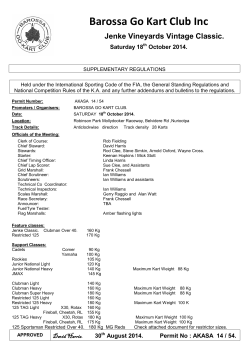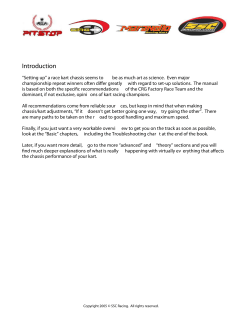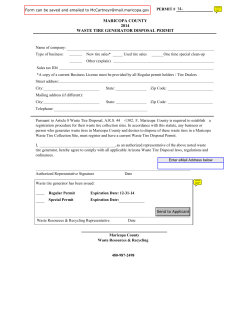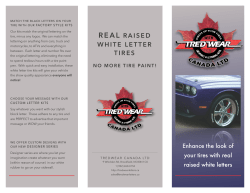
Beginners Guide to Karting and Racing at SIMA
Beginners Guide to Karting and Racing at SIMA Have you ever wondered how your favorite racer got their start in motorsport? I’ll tell you the answer – karting! Considered by many to be the purest form of motorsport, karting is a challenging, competitive and extremely fun sport that the whole family can participate in. At the Sumas International Motorsport Academy (SIMA), we offer a number of services designed to make your karting experience as easy and enjoyable as possible. In addition to world class driver coaching, the staff at SIMA are always happy to answer questions and offer support. As the home of Italian Motors USA, SIMA grantees you access to some of the finest products in karting – Italkart, IAME and TM engines. SIMA club races take place on average once per month, year round and rain or shine. Club racing at SIMA is friendly but competitive – attributes that so rarely come together in any setting. No matter your skill level or expertise, there are always people to race against at SIMA and always people willing to lend a hand. For anyone who wants to turn a few laps before competing in a race, SIMA is open year round and dedicates approximately 90% of the schedule to open practice days. Please use this helpful guide as a tool which will aid you in not only understanding more about kart racing, but also understanding what it takes to get started in this great sport! The Club The Sumas International Motorsport Academy is the realization of a lifelong dream. When a piece of property adjacent to the IMUSA distribution center went up for sale, owner and industry leader Claudio Valiante seized the opportunity to build the race track he had always wanted. After several months of construction, SIMA was completed in the summer of 2010. Today, SIMA continues to grow and build strong ties with the local community and within the region. The Karts Let’s begin by clarifying a common misconception that many people have! A racing kart is different than a concession (rental) kart or a back-yard go kart. Many people are unaware that racing karts even exist – let alone of their amazing capabilities. The differences between a concession kart and a racing go kart are accurately illustrated by the differences between a Cessna airplane and an F16 fighter jet. A racing kart is a purpose built racing machine, designed with one objective in mind. These true racing machines are direct descends of open wheel formula cars. As in any form of motorsports there is always more involved then what meets the eye. The kart chassis used is a tubular alloy frame, configured specially for sprint type road racing. There are a number of go kart chassis and engine manufacturers, nearly all of them operating from the homeland of kart racing – Europe. Things as simple as seat placement and proper driver fit can make a big difference to how a kart handles. There are many specific components that make up the workings of a kart. Track operated by Italian Motors USA LLC Each kart has a drive train which usually consists of a chain and centrifugal clutch. Different sized sprockets are available and can be changed to allow for various engine choices, tracks and conditions. Frequently Asked Questions F.A.Q. #1: How fast do they go? It depends. Factors such as class, engine, gearing and track space are all important. For example Kid Karts have a top speed of 20 to 30 mph and 4 cycles are in the 40 to 50 mph range. The theoretical maximum for TaG and Shifter karts on a long straightaway is between 105 and 125 mph. F.A.Q. #2: How much does a kart cost? There are many variables that need be considered when answering this question. Fortunately, at SIMA there are used kart packages available either as rolling kits or complete kart and engine packages. Buying a used go kart is a great way to save several thousand dollars off the price of a new kart. Used TaG packages start at around $4,500, and shifters are usually around $6,000. At SIMA, you can rest assured that every used (and of course new) kart package we sell is carefully inspected to ensure the safety and integrity of the kart and engine. Because Italian Motors USA is a national level racing team, there is never a shortage of lightly used go karts available for purchase. F.A.Q. #3 I purchased a kart, what do I need to start racing? Congrats! Now you need the proper safety gear. Luckily, everything you need (including all items on the following list) is available at SIMA! 1. 2. 3. 4. 5. 6. Snell approved, full face helmet CIK approved suit CIK approved gloves CIK approved shoes CIK approved neck protector Alternatively, a motorcycle jacket, jeans and high top shoes will suffice. In addition to these things, most people purchase a rib protector. Because of the high levels of grip that karts are able to generate, tremendous strain is often placed on your ribs. Rib protectors minimize this strain, almost always eliminating any rib problems for everyone. Lastly, in order to race competitively you must purchase a transponder that attaches to the kart for timing and scoring. F.A.Q. #4: How hard is it? Again, there is no easy answer to this question. One thing is for sure – karting is just like any other sport, and in order to be good at it, one must dedicate years of practice and hard work. With that said, karting is extremely fun. The difficulty of becoming a world class soccer player never Track operated by Italian Motors USA LLC stopped anyone from playing soccer! The same is true for karting. You don’t need to be on par with Michael Schumacher or Ayrton Senna to thoroughly enjoy the sport. Always keep in mind that you may be racing against experienced competitors. Therefore, showing up at the track and expecting to win your first race is probably a little unrealistic. It is a good idea to set long term goals with measurable results, but at the same time you must remember that kart racing is fun and there is more to fun then just winning. In reality it takes a combination of equipment, setup of the chassis, a good running motor, good tires, a good driver and some racing luck to become a consistent front runner F.A.Q. #5: I have a kart, but I don’t think I’m ready to race, what are my options? The great thing about SIMA is that there are lots of open track days throughout the season to help you gain valuable experience. With a membership, practice days only cost $10 and provide participants with plenty of time to test and tune their equipment. Race Day On race days, SIMA opens at 8am. Participants are encouraged to get to the race track as early as possible. Arriving late puts a strain on your over-all preparedness, adds to the stress level and ultimately lowers your competitiveness. When you arrive, enter the track near the small green warehouse, east of the main entrance and near the railroad tracks on Front St. Before you proceed into the paddock area, you will need to visit the registration booth and sign the appropriate documents. If you registered for the race online (at www.motorsportreg.com, you’ll save $25!), simply sign the waiver and you’ll be on your way. Next, find a pit/parking space. It is always a good idea to try and pit next to a friend. Before you go on the track for practice (practice begins at 10AM), do the following things. 1. 2. 3. 4. 5. 6. 7. 8. Be sure your transponder is charged and on the go kart. If you have any questions as to how a transponder is affixed to the kart, ask a SIMA representative or a fellow racer. Do a complete nut and bolt check. Make sure there are no loose components on the go kart. Check the bolts holding the heim joints to the spindles, the spindle bolts and the wheel nuts. Make sure your rear hubs are tight, so they do not slide. Check your chain tension. At the chain’s tightest point, there should be between ½ and ¾ of an inch of play. The go kart chassis flexes while it is on track, so having enough play in the chain tension is vital to ensuring the longevity of your drive train. Apply chain lube to the chain. Check tire pressure and set it between 9 and 20 lbs – ask a SIMA representative or fellow racer for suggestions. Make sure your go kart has enough gas, and that it is properly mixed. When a two cycle engine runs out of gas, you run the risk of seizing the engine! Properly mixing fuel is simple. When you buy a 5 gallon jug of fuel and a liter of oil from the kart shop, simply empty both into a fuel container/mixing jug and shake! Completely fill out the tech form and hand it in to the grid steward (the person in uniform standing on the grid). Make sure you know the minimum weight for your class. Now you’re ready to go practice! Make sure you have all of your safety gear on! Practice sessions are divided into two groups – junior and senior/4 cycle & jr. 2 cycle and 2 cycle senior. Sessions Track operated by Italian Motors USA LLC are ten minutes long, and you are encouraged to take this time to warm up and familiarize yourself with the go kart and the track conditions. Make sure you clearly understand how to safely merge on and off the track before your first practice session. The general rule is that you should raise your right hand when entering and exiting the track, also when you are stopped on track for any reason. After practice there will be a drivers meeting explaining the procedures for the race – don’t hesitate to ask any questions! When the drivers meeting is over, there will be a board displayed which will include starting positions for each class and race. The race structure is simple, each class will have two qualifying heat races and one feature race per event. The Races Be sure to check the order of the races and be prepared when your race is called. Make sure you are at the grid at least five minutes before your race. Once you are on the grid and ready, you can warm up your go kart (if it is under 70 degrees outside).When lifting your kart to and from the stand, other participants are always willing to lend a hand. The grid steward will inform you of your starting position. Pay attention to the number of the kart ahead of you, that is who you will be staring behind! Also, remember to close your visor completely as soon as you enter the track – a rock in your eye could end your racing career forever! Everyone in your class will have one warm up lap. Take this time to warm up your tires and get into starting position. Try and stay about one foot away from the kart ahead of you as you bunch up for the start. Also, do not be alarmed if a kart behind you gives you a slight nudge. As you pass the scoring tower for the second time, the flagger will either give everyone the green flag or he/she will withhold it. In the event that the flagger does not wave the green flag, that means that everyone will try one more time, and that everyone needs to do a better job of staying in grid formation. If the flagger waves the green flag, the race is on! Concentrate on maintaining a consistent driving speed. Hold your line and do not be alarmed if someone passes you. Be sure to give competitors plenty of room if you are the one executing the passing maneuver. If for any reason you have problems with your go kart, be sure to raise your hand immediately as you come to a stop. Then quickly but safely pull your go kart off the track. When the race is over, proceed onto the track exit and stop before you reach the scale. Always roll your go kart onto the scale – never drive it on! Welcome to racing at SIMA and good luck catching your first checkered flag! Remember success takes time, so don’t get discouraged if you don’t see immediate results. With some patience and effort you’ll be winning before you know it. Class Structure In racing, competitors are split into different categories which are referred to as classes. Classes are normally determined by age of driver and choice of engine; however other factors such as competitiveness and weight also matter. Kids as young as 5 can race and so can adults over the age of 60! For each class, there are specific tire compounds that competitors must use. Spec tire rules are designed to eliminate unfair advantages gained by tire compounds that have more grip (tires that are softer, or “stickier”) than others. This rule is crucial to maintaining a fair, competitive and fun racing environment. Additionally, there are minimum weight rules that differ according to class. For example, consider two go karts with equal power and the same tire compound. One go kart weights 355 pounds while the other weighs only 320 (kart & driver). The lighter kart enjoys a distinct competitive advantage over the heavier one. As a result, there are minimum weight requirements that equalize competitors and eliminate unfair weight advantages Track operated by Italian Motors USA LLC (or disadvantages). As a result, many competitors are required to add weight to their go karts. To enforce this rule, karts are scaled as they exit the track after each and every event. Lastly, each kart is required to have a transponder, which allows timing and scoring personnel to record racing position and lap times. The class structure at SIMA is as follows. Jr. I Jr. II Jr. III Gazelle (230 lbs), Mini Swift (240 lbs) unrestricted and 100 Leopard w/17mm intake & 25mm Exhaust (250 lbs) (See below for tire rule) 100 Leopard w/25mm Exhaust (265 lbs) (See below for tire rule) 125 Leopard w/30mm Exhaust (320 lbls) (See below for tire rule) TAG SR. - 125 Leopard 365, Rotax 365 (see. Rotax Rules for engines specs), Rok (375 lbs), X30 (370 lbs), Dragon (390lbs) Yamaha - (320lbs) TAG Sr. / Masters (See below for tire rule) (Age 35+) IAME Sr. Shifter/ Shifter Novice 4 Stroke Sr & Jr. / Novice Tag RENTAL KART RACE Masters- 125cc Leopard - (390lbs) Rotax - (390lbs) X30 - (390lbs) Dragon - (410lbs) Yamaha - (320lbs) 125 Leopard (365 lbs), X30 (370 lbs), Dragon (395lbs) (See below for tire rule) Stock – Moto, Honda & TM Tag ICC (385 lbs) Modified Honda, Tag ICC, IAME, TM Cross (410lbs) (See below for tire rule) As per IKF (See below for tire rule) WWR: Re Driver Wanted! $95 per person. Includes qualifying, heat race and final. No previous racing experience required. Must be over 15 years old. Winner receives free entry in the next race.. Approved tires for Winter Series SR - Bridgestone YKC or YLC, Maxxis HG3, MG Yellow red & White, Mojo D2 Approved tires for JR II and III- Bridgestone YKC or YLC and MG Yellow or White Approved tires for JR and 4 cycle - Bridgestone YKC or YLC and MG Red Track operated by Italian Motors USA LLC Additional Information SIMA Racing 529 W. Front St Sumas, WA 98295 360-988-5104 info@simaracing.com Track website: www.simaracing.com Kart shop website: www.italianmotors.com Italkart website: www.italkart.com Track operated by Italian Motors USA LLC Done WEEK-END RACE WEEK BEFORE RACE My kart is ready to race My kart needs the following: Chain, sprocket, spark plugs, engine parts, bodywork, tires (rain/slicks), fuel, oil, chain lube, brake cleaner, number panels and numbers of appropriate size/color (see rule book) Other items that I think of: _________________________________ I have all the tools/gear I need I need some tools/gear for the race weekend: Tool box, tire gauge, fuel mixing jug, fuel container, rags, WD40, brake cleaner, chain lube, work bench, rule books, license, log book, fire extinguisher, first-aid kit, awning, transponder, racing suit, rain suit, helmet, rib-protector, racing shoes, racing gloves, duct tape, notebook & pen Other tools/gear I can think of: _____________________________ Charge my transponder Fix my kart & equipment Break-in my engine RACE WEEKEND I plan to be at the track at am Saturday I need to register and get pit passes – for this I need money/credit card, license, transponder THE ESSENTIAL TOOLS I NEED: Track operated by Italian Motors USA LLC
© Copyright 2025
















